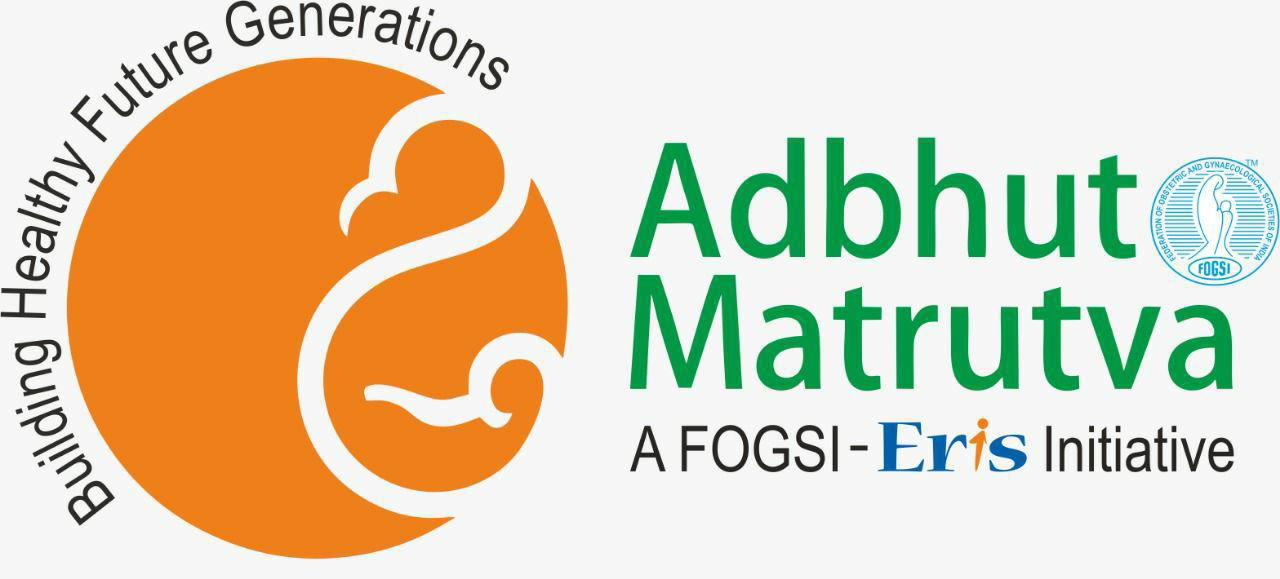
Dr. PRATIMA MITTAL
Second Trimester work up and Algorithms
INTRODUCTION
- The goal of prenatal care is to ensure the birth of a healthy baby with minimal risk for the mother.
- Antenatal care represents a series of assessments and interventions over time. It is not a single interventio
AIM OF ANTENATAL CARE
- To provide advice, reassurance, education and support for woman and family.
- To treat associated minor symptoms.
- To provide an ongoing screening program to confirm that pregnancy continues to be low risk.
- To identify high risk pregnancies so that appropriate, timely management is provided to prevent or minimize morbidity & mortality
ATIMING of ANC
IDEALLY
Prenatal care should be initiated in the first trimester and should provide comprehensive medical care in second and third trimester.
BUT
Less than 50 percent of women in developing regions receive early antenatal care
So second trimester care is important, even after the initial prenatal assessment and patient counseling

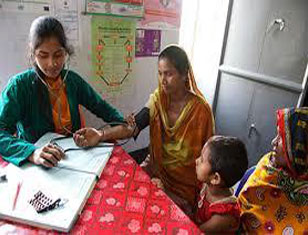
ANTENATAL CARE IN SECOND TRIMESTER
Second Trimester is from 14 to
28 weeks of gestation
Antenatal care in second Trimester is directed at
- Early, accurate estimation of gestational age
- Ongoing evaluation of the health status of both mother and fetus
- Anticipation of problems and intervention.
FREQUENCY OF VISITS
ACOG RECOMMENDATIONS
NULLIPAROUS WOMEN WITH UNCOMPLICATED PREGNANCIES
(16 VISITS) :-
- Every 4 weeks tilL 28 weeks
- Every 2 weeks from 28 -36 weeks
- Weekly until delivery
- Parous woman with uncomplicated medical and obstetrical histories = less frequently.
- Women with problems are seen more frequently, depending on the nature of the problems.
NICE GUIDELINES
- 10 appointments for nulliparous women
- 7 appointments for parous women
- Each visit should have a specific purpose/goal
WHO GUIDELINES 2016
- Minimum of eight antenatal visits for all women, regardless of parity
- One visit in the first trimester
- Two in the second trimester
- Five in the third trimester.
- High risk pregnancies need additional care
CARE PROVIDER ?
Standard one -on-one care
Standard one-on-one care by midwives, obstetriciangynecologists, family medicine clinicians, and maternal-fetal medicine (MFM) subspecialists.
Subspecialty obstetrical care
- chronic health conditions
- pregnancy complications in the past
- develop complications during their current pregnancy
Referral to a MFM subspecialist
Multidisciplinary care
Women with medical comorbidities: collaborative multidisciplinary care by a team including obstetric provider and appropriate medical or surgical subspecialists, specialists in genetics, anesthesia and pediatrics.
Group prenatal care
- Participants with the same month of expected delivery receive the majority of their care in a group setting.
- The only private time between patient and clinician is during the initial prenatal assessment, when health concerns involving need for privacy arise, and during cervical assessment late in pregnancy.
- Majority of the visit, which may last two hours, involves facilitated group discussion, education, and skills building to address explicit learning objectives in prenatal care, childbirth preparation, and postpartum and parenting roles.

INITIAL EVALUATION IF FIRST VISIT IN SECOND TRIMESTER
History
- Medical/Obstetrical history
- Psychosocial history
- Correct estimation of period of gestation.
Examination
General Physical Exam : Resp /cardiac system
Obstetric Examination
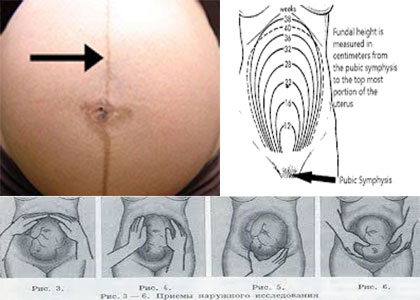
INITIAL EVALUATION IF FIRST VISIT IN SECOND TRIMESTER
Standard panel
- Rhesus type and antibody screen
- Hematocrit or hemoglobin and mean corpuscular volume
- Rubella immunity and varicella
- Qualitative assessment of Urine protein
- Urine culture
- Cervical cancer screening acc to standard guidelines
- Human immunodeficiency virus
- Syphilis
- Hepatitis B virus
Standard panel
- Thyroid function
- Type 2 diabetes
- Infection
- Gonorrhea
- Hepatitis C
- Tuberculosis
- Toxoplasmosis
- Bacterial vaginosis
- Trichomonas vaginalis
- Herpes simplex virus
- Cytomegaloviru
- Zika
- Chagas disease

Ongoing Assessments
Screening and diagnostic testing if not performed at the first prenatal visit or later in the first trimester are done now :
- Red cell antibodies (Rh Negative Prge)
- Current or past infection (sexually transmitted diseases, bacteriuria, rubella immunity)
- Inherited disorders (eg, cystic fibrosis, fragile X, spinal muscular atrophy, hemoglobinopathy)
- Fetal aneuploidy (eg, trisomy 21) screening
- Thyroid disease
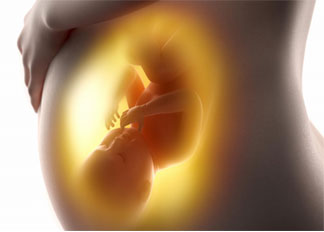
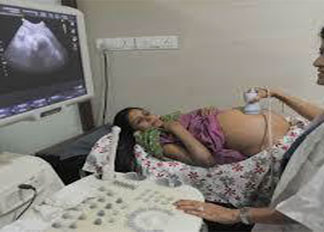
INITIAL EVALUATION IF FIRST VISIT IN SECOND TRIMESTER
Ultrasound examination Discussion of screening and testing for genetic abnormalities in offspring
Aneuploidy
Carrier screening = ethnic-specific, panethnic, and expanded carrier screening acceptable strategies
- Low Risk: Conventional Screening
- High Risk : Cell - free DNA Screening
Aneuploidy Screening
SONOGRAPHY : SECOND TRIMESTER
- Fetal number
- Fetal presentation
- Placental localization
- AFI
- Fetal biometry and EFW
- To r/o CMF
- To evaluate maternal pelvic masses
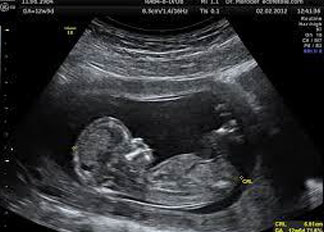
15 to 24 weeks of Gestation:Screening
- Neural tube defects — maternal serum alpha-fetoprotein and ultrasound are both effective methods.
- Trisomy 21 — Quadruple test= level of alpha-fetoprotein (AFP), unconjugated estriol (uE3), hCG, and inhibin A in maternal serum between 15 and 22 weeks of gestation.
- Fetal anomalies — ultrasound screening for fetal structural anomalies, is optimally performed in the second trimester, between 18 and 22 weeks of gestation
- Cervical length — Transvaginal ultrasound measurement of short cervical length between 16 and 28 weeks of gestation is associated with an increased risk of spontaneous preterm birth
- 35 weeks. It can be measured when the patient undergoes ultrasound examination for fetal anomalies.
Maternal serum marker pattern in selected fetal syndroes

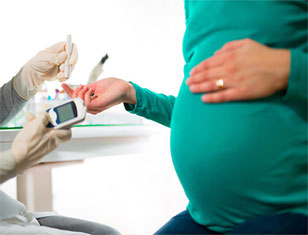
24 to 28 weeks of Gestation: Screening
- Gestational diabetes — Universal screening for gestational diabetes is recommended at First visit, and repeated at 24 to 28 weeks of gestation.
- RBC antibodies — In Rh(D)-negative women, red cell (RBC) antibody screening is repeated at 28 weeks of gestation and anti-D immune globulin is administered.
- Hemoglobin or hematocrit — The hemoglobin or hematocrit should be rechecked to assess for anemia.
SCREENING FOR DEPRESSION
- Pregnant women should be assessed AT LEAST ONCE during pregnancy or the postpartum period for depression and anxiety symptoms using a validated screening tool
- The Edinburgh Postnatal Depression Scale is commonly used
- No consensus for optimal time
- Women who screen positive referred for further evaluation and counseling


FOLLOW-UP VISITS Ongoing Assessments
- Measurement of blood pressure
- Measurement of weight
- Urine dipstick for protein, although the value of this test is questionable in women with normal blood pressure
- Assess fetal growth either through measurement of fundal height or by ultrasound evaluation for women with risk factors for intrauterine growth restriction.
- Assessment of maternal perception of fetal activity
- Assessment of significant events since prior visit, such as recent travel, illness, stressors, or exposure to infection (eg, Zika virus) etc.
FOLLOW UP VISITS-Periodic assessments
Prenatal screening should be performed early within recommended intervals to allow adequate time for:-
- Follow-up of screening tests
- Performance of diagnostic tests
- Counseling about test results
- Discussion of management options, including termination of pregnancy if the patient chooses this approach.


MANAGEMENT OF PREGNANCY COMPLICATIONS -Risk approach
- Risk is the possibility of coming to harm
- Vulnerability is the degree to which one would be adversely impacted by the risk
- Vulnerability is a parameter which we can influence
Assessmrnt Tool

Management of common discomforts
- Nausea and vomiting
- Gastroesophageal reflux disease
- Constipation
- Hemorrhoids
- Rhinitis and epistaxis
- Gingivitis
- Difficulty sleeping
- Headache
- Back pain and sciatica
- Leg cramps
- Peripheral edema
- Varicose veins
- Diarrhea
- Urinary frequency and nocturia
NAUSEA & VOMITING
- Nausea is the most common GI symptoms during pregnancy (80-85%) during 1st trimester
- Nausea + vomiting - 52%
- Nausea & vomiting of pregnancy manifests before 9 wks of POG & subsides by 16-20 wks of pregnancy.
- Treatment - reassurance
- Dietary modifications
- Ginger 250 mg thrice/day
- Acupressure
- Pharmacological t/t


BACKACHE
- Low backache – 70% of pregnant ladies
- Causes –
- excessive straining / fatigue
- excessive bending, lifting, walking
- acute strain / fibrositis
- Reduced by preventing bending, sitting with back support
- Avoid high healed shoes
- severe backache – orthopaedic consultation
PAIN ABDOMEN
Pain abd results from 3 sources
- Physiological effects of pregnancy
- pathological causes during pregnancy
- pathological causes unrelated to pregnancy
Physiological conditions causing pain abd
- Round ligament pain
- Braxton hicks contractions
- Misc – heart burn, excessive vomiting, constipation

| RL pain | BH contractions | Misc (heart burn, contipation) | |
|---|---|---|---|
| pain | cramping/stabbing agg by movement | irregular tightening | mild/varied |
| prev anomaly | - | - | fibroid |
| urine | - | - | - |
| trimester | late 1 st / 2 nd | late 2 nd / 3 rd | 3 rd |
VAGINAL DISCHARGE
- Pregnant women usually produce more vaginal discharge due to increased mucus secretion in response to hyperestrogenemia.
- Troublesome & copious vaginal discharge may indicate infection & a per speculum
exam should
be done.
- Fishy –smelling discharge
- Curdy white discharge
- Foamy greenish discharge
HEART BURN
- Reflux of gastric contents in lower oesophagus
- Occurs in late trimester
- Due to upward displacement & compression of stomach by uterus & relaxation of lower oesophageal sphincter
- Management :-
- Dietary modification
- Lying propped up
- Antacids
- Sodium Alginate


CONSTIPATION
- Common during pregnancy
- Caused by increased bowel transit time & large bowel compression by enlarged uterus or by presenting head
- May be ass with pain & bleeding during daefecationMay be ass with pain & bleeding during daefecation
- Management :-
- High fiber diet
- Plenty of fluids
- Laxatives
- Stool softener
HAEMORHOIDS
- Exacerbated by pregnancy
- Caused by
- Obstruction of venous return by enlarged uterus
- Constipation during pregnancy
- Symptoms :-
- bleeding per rectum
- pain (thrombosis)
- Management :-
- High fiber diet
- Stool softener
- Local anesthetic agents
Assessment of Fetal Well Being at ANC
- Progressive Fundal height growth as per expectation
- Adequate maternal perception of fetal movements
- Ultrasonographic fetal assessment esp. for anomalies
Counseling

Counseling about Diet, Exercise, Rest, Immunisation,weight gain , Alcohol, Smoking, Dress, Personal hygiene and warning symptoms
SECOND TRIMESTER WORK UP (14-28 Weeks)
Initial Booking in first trimester
History & Examination
- Medical/obstetrical history
- Psychosocial history
- Estimation of gestational age
Recommended
- Wt, BP, Hb
- Blood group and Rh (Both partners)
- Urine — R/M, VDRL, HpB, HIV, TSH; DIPSI Dating Scan +NT + Dual marker + Cervical length
Preferable
- BMI, MAP, CBC, (Peripheral) smear, electrophoresisHPLC
- MSU + Culture HCV, Rubella IgG
Ongoing Preg in Second trimester
Recommended
- Repeat blood tests
- Hemoglobin
- TSH
- Urine dipstick DPISI
- Quadruple/triple marker Anomaly scan Cervical length
Preferable
- NIPT
- Uterine artery
- Doppler 2D-4D scan
- Fetal
- Echocardiography
Initial Booking in Second trimester
History & Examination
- Medical/obstetrical history
- Psychosocial history
- Estimation of gestational age
Rcommended
- Wt, BP, Hb
- Blood group and Rh (Both partners)
- Urine — R/M, VDRL, Hepatitis B, HIV, TSH; DIPSI
- Quadruple/triple marker
- Anomaly scan
- Cervical length
Preferable
- BMI, MAP, CBC, (Peripheral) smear, electrophoresis HPLC
- MSU + Culture HCV,
- Rubella IgG
- NIPT
- Uterine artery Doppler
- 2D-4D scan
- Fetal echocardiography
IDENTIFY HIGH RISK CASES AND INDIVIDUUALIZE MANAGEMENT
NUTRITION CALORIE REQUIREMENTS
- Pregnant women of normal weight with a singleton pregnancy need to increase daily caloric intake by 340 and 450 additional kcal/day in the second and third trimesters, respectively, for appropriate weight gain
- Recommended daily allowance (RDA) for an Indian reference woman ( 20 – 29 yrs, weighing 50 kg)
| particulars | Kcal/day | protein (g/d) | fat (g/d) |
|---|---|---|---|
| nonpregnant | 2200 | 50 | 20 |
| pregnant | +300 | +15 | 30 |
| lactating | +550
+400 |
+25
+18 |
45 |


NUTRITION AND MICRONUTRIENTS
-
Balanced Diet (ICMR)
- Carbohydrate – 50-70%
- Protein – 15 – 20%
- Fat – 20 – 30% ( essential fatty acid – 50%)
- Micronutrients
- The Institute of Medicine and the Centers for Disease Control and Prevention recommend multiple-micronutrient supplements (commonly called multivitamin supplements) for pregnant women who do not consume an adequate diet or may have malabsorption.
- Well - nourished women may not need multiple - micronutrient supplements

NUTRITION FOOD HYGIENE
- Practice good personal hygiene (frequent hand washing)
- Consume only meats, fish, and poultry (including eggs) that are fully cooked
- Avoid unpasteurized dairy products and fruit/vegetable juices
- Thoroughly rinse fresh fruits and vegetables under running water (about 30 seconds) before eating
- Avoid eating raw sprouts (including alfalfa, clover, radish, and mung bean). Bacteria can get into sprout seeds through cracks in the shell; these bacteria are nearly impossible to wash out.
- Wash hands, food preparation surfaces, cutting boards, dishes, and utensils that come in contact with raw meat, poultry, or fish with hot, soapy water. Countertops can be sanitized by wiping with a solution of one teaspoon liquid chlorine bleach per quart of water and leaving to dry over 10 minutes.
EXERCISE DURING PREGNANCY RECOMMENDATIONS
- Physical activity in pregnancy has minimal risks and benefits most women, but some modification to exercise routines may be necessary because of normal anatomic and physiologic changes and fetal requirements.
- Before recommending an exercise program, a thorough clinical evaluation should be done to ensure that the patient does not have a medical reason to avoid exercise.
- Women with uncomplicated pregnancies should be encouraged to engage in aerobic and strength conditioning exercises before, during, and after pregnancy.
- Bed rest, although frequently prescribed in the past (for prevention of second-trimester loss, preterm birth, and other conditions) is rarely indicated and, in most cases, allowing ambulation such as walking should be considere
EXERCISE DURING PREGNANCY ACOG(2015)
A thorough clinical exams mandatory before recommending an exercise program.
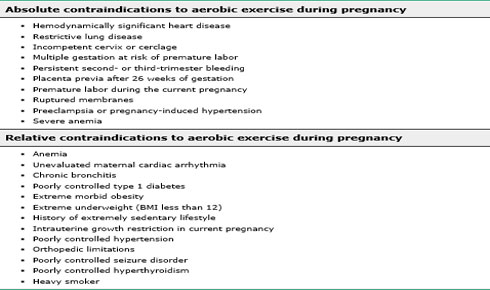
EXERCISE DURING PREGNANCY ACOG(2015) A thorough clinical exams mandatory before recommending an exercise program. In the absence of C/I –regular, moderate intensity physical activity for 30 min/day is recommended for pregnant women Activities with a high risk of falling, abdominal trauma/ scuba diving (increase fetal risk of decompression sickness) should be avoided.
TRAVEL
CONSIDER SEVERAL ISSUES:
- Risk of pregnancy complications away from their usual source of medical care, as well as the availability of medical resources and their medical insurance coverage at their destination.
- Increased risk of venous thromboembolism during pregnancy and with prolonged immobility during the trip.
- Issues related to air travel (eg, access to medical providers, lower oxygen environment, restricted movement).
- Potentially increased risk of exposure to infectious diseases (eg, travelers' diarrhea, malaria, Zika virus), as well as prophylaxis, prevention and treatment of these diseases.

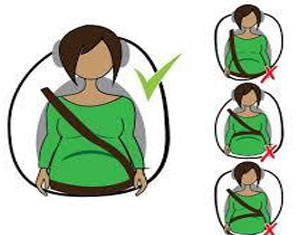
TRAVEL: AUTOMOBILE
Use of seat belts and air bags
The correct use of seatbelts in pregnancy:
- Above and below the bump, not over it.
- Use three-point seatbelts with the lap strap placed as low as possible beneath the ‘bump’, lying across the thighs with the diagonal shoulder strap above the bump lying between the breasts.
- Adjust the fit to be as snug as comfortably possible
TRAVEL:AIR TRAVEL
- Most airlines allow women to fly up to 37 weeks POG.
- Commercial airline travel is generally safe for women with uncomplicated pregnancies ;Fetal heart rate is not affected during flight if the mother and fetus are healthy
- Women with complicated pregnancies that may be exacerbated by flight conditions or require emergency care should avoid air travel.
- All airline travelers should maintain hydration and periodically move their lower extremities to minimize stasis and reduce the risk of venous thrombosis; use of compression stockings and avoidance of restrictive clothing may also be helpful. Seat belts should be worn continuously to protect against injury from unexpected turbulence.
- Supplemental oxygen should be administered to pregnant women (eg, women with sickle cell disease, severe anemia [hemoglobin "lessthan 8 g/dL"], or cyanotic heart disease) who must travel and may not tolerate the relatively hypoxic environment of high altitude flying, even in pressurized aircraft.


Hair dyes and Cosmetic products
- Exposure to hair dyes or hair grooming/styling products results in very limited systemic absorption, unless the integrity of scalp skin is compromised by disease.
- Therefore, these chemicals are unlikely to cause adverse fetal effects in women with a normal scalp
- Plant-based hair dyes are probably safe and there is no information on whether non-ammonia versus ammonia-based products are safer.
- Avoid ammonia- and peroxide-based products, given the wide availability of non-ammonia-based products.
- Use these products in a well-ventilated area since women with asthma/allergies may be more sensitive to the scents during pregnancy.
- Avoid new products since skin sensitivity is more common in pregnancy.
- limited data on the safety of cosmetics. Skin may be more sensitive in pregnancy. Some nail polishes have toludene, formaldehyde, and dibutyl phthalate; these toxins may be inhaled when applied or absorbed from the nail bed, so it is prudent to apply nail polish in a well ventilated place.
Sexual intercourse in pregnancy
PREGNANT WOMAN SHOULD BE INFORMED THAT SEXUAL INTERCOURSE IN PREGNANCY IS NOT KNOWN TO BE ASSOCIATED WITH ANY ADVERSE OUTCOMES.
- In the absence of pregnancy complications (eg, vaginal bleeding, ruptured membranes), there is insufficient evidence to recommend against sexual intercourse during pregnancy.
- Whenever abortion or preterm labour is a threat, coitus should be avoided. Otherwise it is allowed with less frequency and violence.
- Abstinence in the last 4 weeks of pregnancy for fear of ascending infection may be considered

Immunization cdc 2015 recommendations
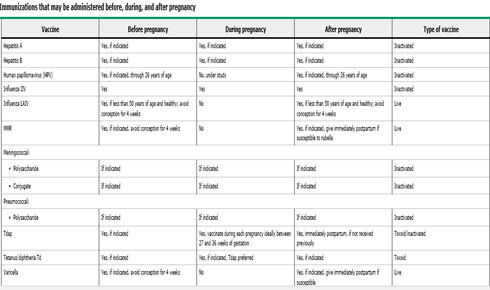
IMMUNISATION
Tetanus toxoid. 2 doses or one dose of T Dap
Tetanus Toxoid
1st dose: Between 16–20 weeks, 2nd dose: After 4–6 weeks after the 1st dose.
Tdap
- Can replace TT (wherever available)
- Single dose replaces both doses of TT
- Administered 28–36 weeks, if previously immunized
- If not Immunized then Two doses of TT and 1 dose of T dap
Influenza:
Infuenza vaccine (during flu season) Intramuscular after first trimester .(FOGSI Recomm 2017)
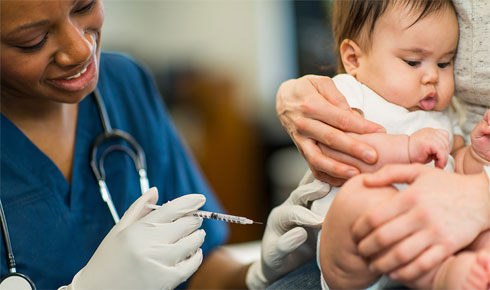
IMMUNISATION
VACCINES CONTRAINDICATED IN PREGNANCY:
-
Live attenuated viral /bacterial vaccines
- BCG
- HPV
- Measles
- Mumps
- Rubella
- Varicella
- Yellow fever – contraindicated except if exposure is unavoidable
Recommended vaccines under “Special Situations”
- Rabies: Where the benefits outweigh the risks involved
- Hepatitis A
- Hepatitis B
- Cholera
- Typhoid
Prevention of infection {ACOG}
- Women should be offered routine screening for asymptomatic bacteriuria by midstream urine culture early {12 and 16 wks} in pregnancy, Identification and treatment of asymptomatic bacteriuria reduces the risk of pyelonephritis.
- Routine screening for bacterial vaginosis should not be offered because evidence suggests that : identification and treatment of asymptomatic bacterial vaginosis does not lower the risk for preterm birth and other adverse reproductive outcomes.
- Chlamydia screening should not be offered as part of routine antenatal care.
- Serological screening for hepatitis B virus has to be done to provide effective postnatal intervention to decrease the risk of mother-to child transmission
- Screening for syphilis has to be done in all pregnant women at first prenatal visit. Repeat serologic testing at 28 wks and delivery is recommended in women at increased risk.
- Rubella susceptibility screening should be done early in antenatal period to identify women, at risk of contracting rubella infection and to enable vaccination in the postnatal period for the protection of future pregnancies.
- Pregnant women may not be offered routine screening for hepatitis C virus as there is insufficient evidence to support its effectiveness and cost-effectiveness.
- Routine antenatal serological screening for toxoplasmosis is not required as risks of screening may outweigh the potential benefits.
- Washing hands before handling food
- Thoroughly washing all fruit and vegetables, including ready-prepared salads, before eating
- Thoroughly cooking raw meats and ready-prepared chilled meals
- Wearing gloves and thoroughly washing hands after handling soil and gardening
- Avoiding cat faeces in cat litter or in soil
- Group B streptococcal {GBS} screening can be offered in all women by vaginorectal culture at 35 to 37 wks as recommended by ACOG.
- All pregnant women should be asked about h/o chickenpox. Women with no h/o varicella should have serologic testing for VZV IgG to determine immunity {80-90 % are found to be immune}.
Pregnant women should be informed of primary prevention measures to avoid toxoplasmosis infection such as:
RADIATION
Exposure of high dose ionizing radiation in pregnancy is:
- Lethal------------ preimplantation stage
- Teratogenic----- organogenesis
- Growth restriction & CNS effects---- fetal period
No increased risk of malformations, growth restriction or abortion from a radiation dose of <5 rad.

Employment
- Physically demanding work - increase preterm birth ,IUGR &PIH (Mozurlumich,2000 - 1,60,000 pregnant women)
- Occupation “Fatigue index” incorporates 5 sources of occupation hazard.
- Posture
- Type of work
- Physical exertion
- Mental stress
- Situational factors or environmental hazards (e.g. noise,heat)
- Strong relation b/w adverse pregnancy outcome & fatigue index
- Recommendation for pregnant women ACOG 2002
- Any occupation causing severe physical strain should be avoided
- No work should be continued to the extent that undue fatigue develops
- Adequate periods of rest in b/w work
- Women with prev preg. complication (IUGR, preterm delivery) should minimize physical work
- Women with uncomplicated preg. can continue work till onset of labour

BATHING

- Early pregnancy exposure to hot tub/Jacuzzi at 1000F or higher -increases incidence of miscarriage & NTDs.
- Late pregnancy - (heavy uterus can upset the balance of pregnant woman) - increase likelihood of slipping/ falling in bath tub.
CLOTHING

- Preferably comfortable +non-contricting
- Proper breast support (increase mass of breast may make them pendulous & painful)
SHOES

- Wear low-heeled (but not flat) shoes with good arch support
- High - heeled shoes should be discouraged as they increase lumbar lordosis, back strain and risk of falling
ALCOHOL INTAKE
- Alcohol consumption =negative effects throughout pregnancy
- No exact dose-response relationship between the amount of alcohol consumed and the extent of damage caused by alcohol in the infant.
- Abstinence IS RECOMMENDED from alcohol at conception and during pregnancy (Grade 1C).
- Identification and counseling of women who use alcohol can decrease intake during pregnancy.
- The T-ACE, TWEAK, or AUDIT-C screening tool can be used to identify women who may be at risk for prenatal alcohol use.
- For pregnant women who consume alcohol but are not heavy drinkers, recommend a brief intervention (eg, educational session(s), motivational counseling) rather than no intervention or more extensive alcohol cessation programs (Grade 1A).
- Women with heavy drinking patterns who are unlikely to reduce their consumption should be referred to professional alcohol treatment.


CIGARETTE SMOKING
- Women who smoke/exposed to secondhand smoke during pregnancy are at greater risk for spontaneous pregnancy losses, preterm delivery, low birth weight (LBW), preterm premature rupture of membranes (PPROM), placenta previa, abruptio placentae, and stillbirth. Most of these risks are reduced by smoking cessation
- Quitting at any time during pregnancy can have some beneficial effects. Women are more likely to be successful if encouraged to quit, rather than cut down.
- The five A's (ask, advise, assess, assist, and arrange) provide a general approach to helping patients stop smoking
- For women who are heavy smokers and are unable to quit on their own, pharmacotherapy is advised(Grade 2B). Nicotine replacement therapy and bupropion are reasonable first-line drug options.
NOT RECOMMENDED
SIGNS AND SYMPTOMS THAT SHOULD BE REPORTED TO THE HEALTH CARE PROVIDER
OBSTETRIC
- Vaginal bleeding
- Leakage of fluid per vagina
- Decreased fetal activity
- Signs of preterm labor (eg, low backache; increased uterine activity compared to previous patterns; menstrual-like cramps; diarrhea; increased pelvic pressure; vaginal leaking of clear fluid, spotting or bleeding, contractions)
- Signs of preeclampsia (eg, headache not responsive to acetaminophen, visual changes that do not resolve after a few minutes, persistent right upper quadrant abdominal pain)
- Signs or symptoms suggestive of a MEDICAL OR SURGICAL DISORDER

